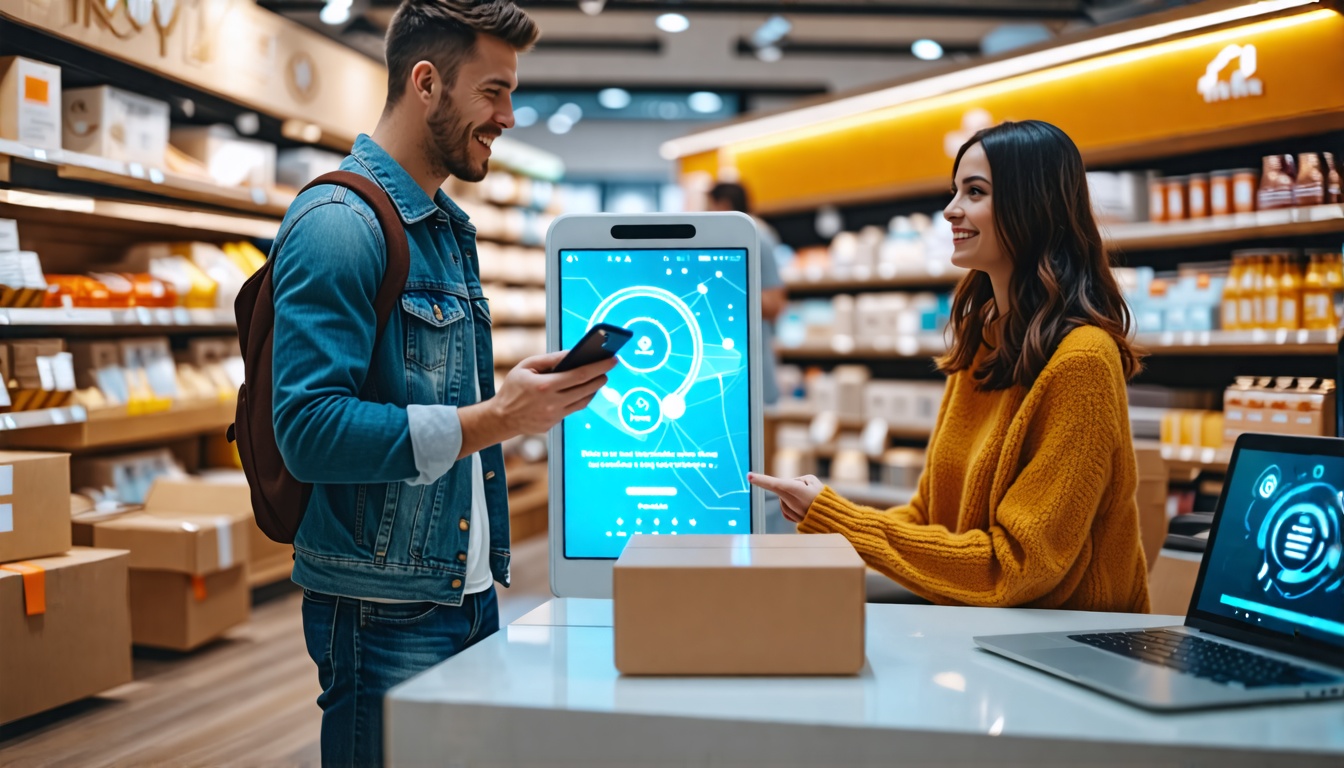 Reading Time: 8 minutes
Reading Time: 8 minutesIntroduction: The evolving Retail landscape
In today’s rapidly altering retail environment, businesses relentlessly seek ways to foster enduring customer loyalty. The digital age has ushered in changes unforeseen just a few decades ago, compelling retailers to rethink their strategies. While discounts and loyalty cards sufficed to keep customers returning, today’s shoppers demand more personalized, seamless experiences across every interaction with a brand. This paradigm shift marks not only a change in tactics but also a significant transformation in mindset. The purpose of this article is to explore how omni-channel strategies can play a pivotal role in enhancing customer loyalty. We will delve into various facets of omni-channel retailing, discuss how leveraging data and AI can refine decision-making, and examine the integration of online and offline experiences. Finally, we’ll cover the challenges of omni-channel implementation and future trends that can shape the retail landscape.
Understanding omnichannel retailing
Omni-channel strategies for improving customer loyalty in Retail retailing encompasses a cohesive integration of various online, offline, mobile, and more platforms to provide customers with a seamless shopping experience. Unlike multi-channel retailing, which operates distinct channels often independently, omnichannel strategies aim to create an interconnected ecosystem where each channel works harmoniously with the others. This streamlined approach is no longer optional but essential for modern retailers to meet consumer expectations. Today’s savvy customers don’t just want but expect a harmonized experience, be it online shopping, in-store purchases, or interactions through social media. According to Google research, 90% of multiple device owners switch between devices every day, using, on average, three devices to complete a task.
A true omni-channel experience ensures that customers can transition smoothly between platforms without losing the thread of personalized engagement, enhancing their overall journey and building lasting loyalty.
Implementing an effective omnichannel strategy requires a significant investment in technology and infrastructure. Retailers must integrate inventory management systems, customer databases, and point-of-sale systems across all channels to provide real-time information and consistent experiences. This integration allows for features such as buy online, pick up in-store (BOPIS), seamless returns across channels, and personalized recommendations based on a customer’s entire shopping history. Moreover, it enables retailers to gather valuable data on customer behavior and preferences, which can be used to refine marketing strategies and improve product offerings. By embracing omni-channel retailing, businesses can not only meet current consumer demands but also position themselves for future growth in an increasingly digital marketplace.
Key components of a successful omnichannel strategy
The foundation of a successful omni-channel strategy lies in a few critical components: integration, personalization, and consistency. Integration ensures that all customer touchpoints are interconnected, providing a unified experience. Personalization involves utilizing customer data to tailor the shopping experience to individual preferences. Consistency guarantees that the brand’s message and quality remain uniform across all channels. These components, when combined, create an enriched customer journey. Another crucial aspect is adaptability; retailers must remain agile in adjusting their strategies based on customer feedback and technological advancements. Implementing a comprehensive data management system and maintaining robust communication channels are vital to effectively support these components.
An omnichannel strategy is a seamless and integrated approach to enhance customer experience and engagement across various channels. Here are the key components:
- Customer-centric approach: At its core, an omnichannel strategy revolves around the customer. It emphasizes understanding customer preferences and behaviors to deliver a cohesive experience. This involves personalizing interactions and ensuring that every touchpoint is aligned to cater to the specific needs and expectations of the customer.
- Integrated technology: Technology integration is crucial for implementing an omnichannel strategy. This includes tools like Customer Relationship Management (CRM) systems, data analytics platforms, and unified communications. These technologies gather and analyze customer data, allowing businesses to provide a consistent and personalized experience across all channels.
- Consistent branding: Brand consistency across all channels reinforces brand identity and trust. Every digital or physical touchpoint should reflect the brand’s values, messages, and aesthetics. This uniformity ensures that customers have a familiar and reliable interaction with the brand no matter where they engage.
- Seamless channel transition: Customers should be able to move smoothly between channels without interruption or loss of context. This means that interactions initiated on one channel, like a mobile app, can be continued effortlessly on another, such as a physical store or contact center. Providing context-aware interactions enhances user satisfaction and loyalty.
- Data-driven insights: Leveraging data is essential for refining and improving the omnichannel approach. Businesses can gain insights into customer journeys, preferences, and behaviors by analyzing customer interactions across all channels. This information is critical for making informed decisions, optimizing marketing efforts, and personalizing customer experiences.
- Responsive customer service: Effective omnichannel strategies require agile and responsive customer service. Support should be easily accessible across all platforms and channels, ensuring customers receive prompt and efficient assistance. Training staff and leveraging technology like chatbots can enhance service delivery and address customer needs in real time.
- Cross-functional collaboration: Achieving an effective omnichannel strategy requires collaboration across various departments within an organization. Marketing, sales, IT, and customer service teams must work together cohesively to ensure seamless and unified customer experiences. Such collaboration helps synchronize strategy implementation and maintain a consistent brand message.
Leveraging data for personalization
Data analytics play a crucial role in creating personalized experiences across different channels. By understanding customer behaviors and preferences, retailers can tailor recommendations and promotions that resonate with individual consumers. This personalization fosters a deeper connection between the brand and its customers, significantly improving loyalty. The Fosfor Decision Cloud(FDC) is an ideal tool for retailers looking to build trustworthy data pipelines. By offering a streamlined process for collating and analyzing data, it enables retailers to gain insights into customer preferences and behaviors, thus facilitating more targeted and effective marketing campaigns. In today’s competitive market, understanding each customer’s unique journey is paramount, and robust data analytics form the backbone of this endeavor.
Integrating online and offline experiences
As retail increasingly merges the digital and physical realms, strategies that blend these experiences become vital. Today’s consumers crave consistency across all interactions, whether they start their shopping journey online and complete it in-store or vice versa. Retailers must ensure a seamless transition between channels to maintain continuity in the customer experience. The FDC’s robust ecosystem aids in creating these integrations by connecting data from various touchpoints to tell a cohesive brand story. This integration ensures that a customer’s preferences and purchase history are accessible wherever they engage with the brand. By unifying online and offline experiences, retailers can create a singular, memorable journey that enhances customer satisfaction and loyalty.
Enhancing customer engagement through omnichannel loyalty programs
Loyalty programs have long been a staple of retail marketing, but in the omnichannel era, they’ve evolved into sophisticated tools for customer engagement and retention. Modern loyalty programs leverage the power of omni-channel strategies to create a more immersive and rewarding experience for customers. By integrating cutting-edge technology and data-driven insights, these programs are more dynamic than ever.
Effective omnichannel loyalty programs seamlessly integrate across all touchpoints, allowing customers to earn and redeem points whether they’re shopping online, in-store, or through a mobile app. This multifaceted integration not only encourages repeat purchases but also incentivizes customers to engage with the brand across multiple channels, building a cohesive brand experience.
Personalization plays a crucial role in these programs. By analyzing data collected from various channels, retailers can offer tailored rewards and personalized recommendations, making customers feel valued and understood. For instance, customers who frequently browse athletic wear online might receive targeted offers for similar products when they visit a physical store, enhancing their shopping journey.
Moreover, omni-channel loyalty programs can incorporate gamification elements to boost engagement. Challenges spanning digital and physical realms, such as scavenger hunts or social media contests tied to in-store visits, can create exciting experiences that strengthen the bond between customer and brand, fostering greater customer loyalty.
By leveraging the FDC’s data analytics capabilities, retailers can gain deep insights into customer behavior across channels, enabling them to refine and optimize their loyalty programs continually. This data-driven approach ensures that loyalty initiatives remain relevant and compelling, fostering long-term customer relationships in an increasingly competitive retail landscape.
Retailers across the globe have increasingly adopted omnichannel strategies for their loyalty programs to enhance customer engagement and drive sales. Here are some case studies showcasing how different retailers have successfully implemented these strategies:
- Sephora: Sephora’s Beauty Insider loyalty program is a standout example of effective omnichannel integration. The program is seamlessly tied into both the in-store and online shopping experience. Members earn points with every purchase, which can be redeemed for gifts or exclusive experiences. Sephora enhances customer engagement by integrating its mobile app, where users can track their rewards, access personalized offers, and book in-store beauty classes. This integration helps create a consistent and personalized experience across channels.
- Starbucks: The Starbucks Rewards program is noted for its integration across digital and physical platforms. Members earn stars on purchases made through the Starbucks app, which can be redeemed for free items. The app also offers features like mobile ordering and payment, a personalized dashboard, and targeted marketing messages. By integrating its loyalty program with its digital ecosystem, Starbucks provides a frictionless experience that encourages repeat business.
- Nike: Nike’s loyalty program, NikePlus, integrates digital and physical channels to offer a personalized shopping experience. Members receive early access to products, special promotions, and invites to exclusive events. The Nike app enhances the omnichannel experience by allowing users to scan items in-store for more information, check inventory levels, and access fitness content. This comprehensive approach nurtures brand loyalty by connecting with customers across various platforms.
- Nordstrom: Nordstrom Rewards is another example of an effective omnichannel loyalty program. Members earn points on purchases in-store and online, which can be redeemed as Nordstrom Notes. The program is integrated with Nordstrom’s mobile app, providing customers with account management, personalized recommendations, and notifications about sales and events. This seamless integration allows Nordstrom to deliver consistent and engaging customer experience across all channels.
By leveraging omnichannel strategies, these retailers effectively enhance customer satisfaction and loyalty by delivering integrated and personalized shopping experiences.
Measuring omnichannel success
Determining the effectiveness of an omnichannel strategy requires a comprehensive evaluation of both qualitative and quantitative metrics. Key performance indicators (KPIs) include customer retention rates, cross-channel engagement levels, and conversion rates. Additionally, customer feedback and satisfaction scores provide valuable insights into how well the omnichannel retail approach meets customer expectations. The FDC enables retailers to quantitatively assess their omnichannel strategies by providing real-time analytics and reports highlighting areas of success and opportunities for improvement. By systematically measuring success, retailers can continually refine and adjust their strategy to ensure they remain aligned with customer needs and market trends, thereby securing a competitive edge.
Creating a robust omnichannel data strategy is increasingly recognized as a powerful driver of business growth. Various studies and reports highlight the impact of omnichannel strategies on business outcomes.
- Increased customer retention and loyalty: According to a report by Omnisend, businesses with omnichannel customer engagement strategies retain, on average, 89% of their customers, compared to 33% for companies with weak omnichannel strategies.
- Improved customer experience: A study by the Harvard Business Review found that 73% of consumers use multiple channels during their shopping journey. Omnichannel approaches cater to these behaviors, enhancing overall customer satisfaction.
- Higher revenue: A McKinsey report highlighted that companies using advanced omnichannel strategies experience a 3-4% increase in annual revenue compared to companies with less advanced strategies. Additionally, a Salesforce research paper indicated that 57% of customers are likelier to buy from retailers offering a seamless experience across all channels.
- Enhanced data integration and insights: Omnichannel strategies help improve data integration, leading to more informed decision-making. According to a white paper by IDC, businesses harnessing integrated data solutions have 2.5 times better customer retention rates.
These statistics highlight the significant impact that a well-executed omnichannel data strategy can have on business performance, ranging from improved customer retention to enhanced revenue. Implementing such strategies can provide a competitive edge in today’s dynamic market environment.
Overcoming challenges in omnichannel implementation
Adopting an omni-channel strategy is not without its challenges. Among the most significant hurdles are ensuring data security, managing inventory across platforms, and maintaining consistent brand messaging. Retailers must navigate these complexities while also addressing technical constraints and organizational silos. The FDC’s comprehensive ecosystem can significantly mitigate these challenges by providing scalable, integrated solutions that streamline operations. With robust data security measures and model management tools, the Fosfor Decision Cloud enables retailers to confidently implement and maintain a harmonious omnichannel experience. Retailers can overcome implementation challenges by taking a proactive approach, continuously refining their strategies, and leveraging technology to facilitate smooth execution.
Conclusion: Embracing omnichannel for long-term success
In conclusion, adopting omnichannel retail strategies is crucial for retailers aiming to build lasting customer loyalty in an ever-competitive market. Retailers can create a seamless and personalized customer journey by integrating data analytics, AI-driven insights, and blended digital and physical experiences. Although challenges exist, advanced data technologies offer robust solutions to help overcome these obstacles and pave the way for successful omnichannel implementation. As the retail landscape continues to evolve, staying ahead with innovative strategies and tools will be essential. Retailers are encouraged to assess their existing strategies and consider leveraging platforms such as the Fosfor Decision Cloud to fully unlock the potential of omnichannel retailing.








